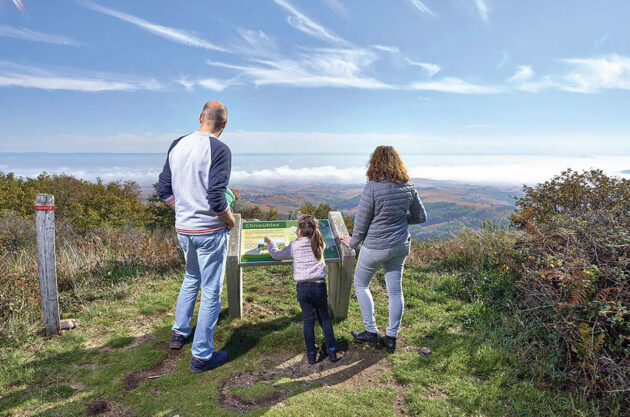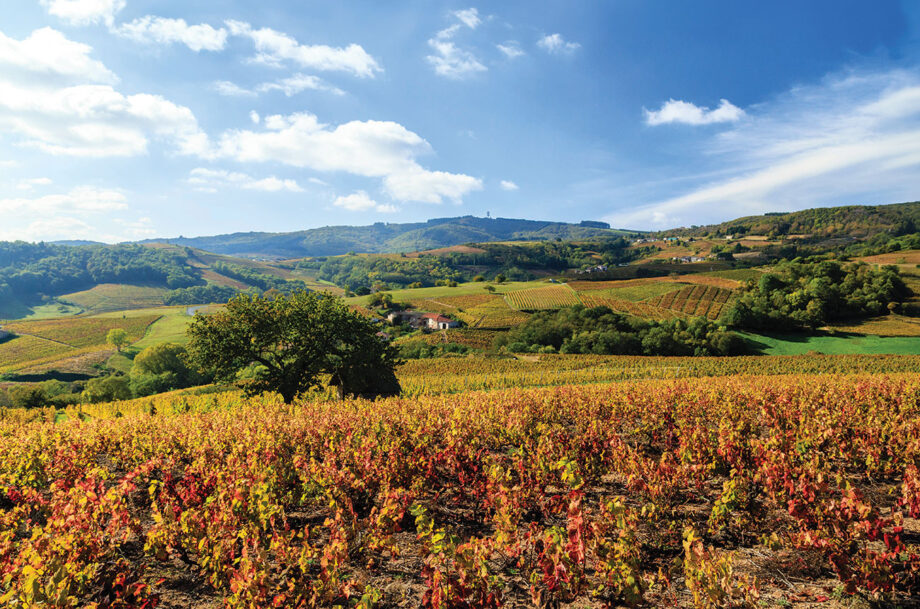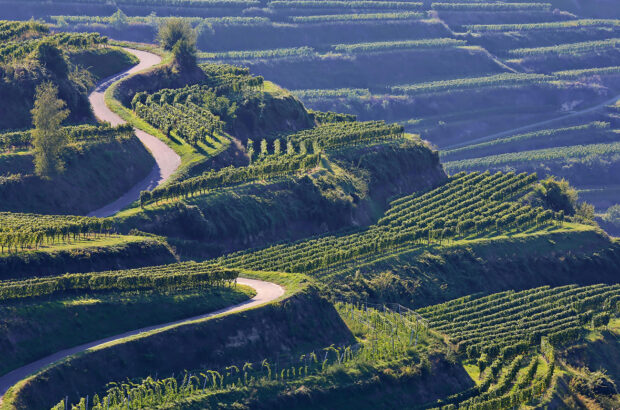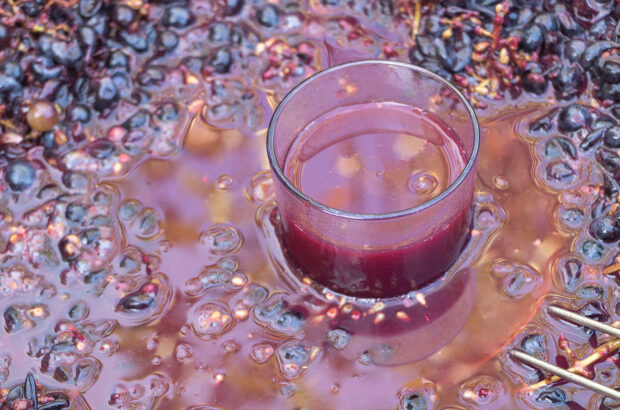Midway between Burgundy’s Côte d’Or and Côte-Rôtie in the northern Rhône, and close to the major city of Lyon, you’d think that Beaujolais would be one of the most visited wine regions in France: a vital pitstop on anyone’s vinous pilgrimage.
Instead, wine tourism in Beaujolais is, to say the least, underdeveloped. Despite the willingness of many of the region’s best domaines to fling their doors open wide and welcome visitors, tasting rooms remain relatively quiet.
Having spent substantial periods in Beaujolais researching my recently published book, The Wines of Beaujolais, I have to say that I think you’re all missing a trick. Leaving aside the warm welcome extended by producers in Beaujolais, there are plenty of other reasons to tempt wine lovers to visit the area.

Expansive views looking eastward over the Saône plain from Maison du Cru. Photo credit: Fabrice Ferrer.
To begin with, there’s the sheer natural beauty of the vineyards. The location of Beaujolais, lying between the Massif Central on its western side and the Alps over to the east, has given rise to an undulating landscape that affords new views every time you turn a corner.
Perching on slopes or nestling in valleys, small villages are built out of local stone – pink granite and blue diorite in the crus in the region’s northern section, and orange-tinged limestone in the south.
In addition to aesthetic pleasures, you’ll find hedonistic ones, too. The region’s wines are on the up: quality is high and the range of styles made from Gamay, the hallmark Beaujolais grape, is surprisingly diverse. Even so, prices remain resolutely affordable.
Good wine goes hand in hand with great gastronomy, of course, and the restaurant scene in Beaujolais has recently rediscovered its mojo.
Visitors can look forward to tucking into Michelin-starred meals, as well as hearty country cuisine. All of this bounty is packed into a tiny region that measures just over 70km in length, and – at most – 20km from east to west.
Most of the visitable wineries are located in the crus and it’s rare to have to drive more than 15 minutes from one tasting to the next. Some wineries are even within easy walking distance of each other.
The 10 Beaujolais crus
Some better known than others, there are 10 individual, named appellations in the Beaujolais region where the highest-quality wines are produced. Running in a roughly contiguous line north to south, between the villages of Chânes and St-Etienne-la-Varenne, they are:
St-Amour | Juliénas | Chénas | Moulin-à-Vent | Fleurie | Chiroubles | Morgon | Régnié | Brouilly | Côte de Brouilly
{"content":"PC9wPgo8aHI+CjxoMyBzdHlsZT0idGV4dC1hbGlnbjogY2VudGVyOyI+SnVtcCB0bzogPGEgaHJlZj0iI21hcCI+QmVhdWpvbGFpcyBtYXA8L2E+IHwgPGEgaHJlZj0iI2VhdCI+V2hlcmUgdG8gZWF0IGFuZCBkcmluazwvYT4gfCA8YSBocmVmPSIjd2luZXJpZXMiPldpbmVyaWVzIHRvIHZpc2l0PC9hPjwvaDM+Cjxocj4KPGgyIGNsYXNzPSJwMiI+PHNwYW4gY2xhc3M9InMxIj5XaGVyZSB0byBzdGF5IGluIEJlYXVqb2xhaXM8L3NwYW4+PC9oMj4KPGRpdiBpZD0iYXR0YWNobWVudF81NzA0MDAiIHN0eWxlPSJ3aWR0aDogNjQwcHgiIGNsYXNzPSJ3cC1jYXB0aW9uIGFsaWduY2VudGVyIj48aW1nIGZldGNocHJpb3JpdHk9ImhpZ2giIGRlY29kaW5nPSJhc3luYyIgYXJpYS1kZXNjcmliZWRieT0iY2FwdGlvbi1hdHRhY2htZW50LTU3MDQwMCIgY2xhc3M9Imxhenlsb2FkIGJsdXItdXAgc2l6ZS1sYXJnZSB3cC1pbWFnZS01NzA0MDAiIGRhdGEtcHJvY2Vzc2VkIHNyYz0iaHR0cHM6Ly93d3cuZGVjYW50ZXIuY29tLm1hc3Rlci5wdWJsaWMua2V5c3RvbmUtcHJvZC1la3MtZXV3MS5mdXR1cmVwbGMuZW5naW5lZXJpbmcvd3AtY29udGVudC90aGVtZXMvc2ltYmEtdGhlbWUvYXNzZXRzL2ltYWdlcy9wbGFjZWhvbGRlci5wbmciIGRhdGEtc3JjPSJodHRwczovL2tleWFzc2V0cy50aW1laW5jdWsubmV0L2luc3BpcmV3cC9saXZlL3dwLWNvbnRlbnQvdXBsb2Fkcy9zaXRlcy8zNC8yMDI1LzExL3dlYi1ERUMzMTYuYmVhdWpvbGFpc190cmF2ZWwubWFpc29uX2RlX3BhZ25ldXhfMjMwOTIwXzAwMV9jcmVkaXRfbWFyaW5lX3Bpb2xhdC02MzB4NDE3LmpwZyIgYWx0PSJtYWlzb24gZGUgcGFnbmV1eCwgYmVhdWpvbGFpcyIgd2lkdGg9IjYzMCIgaGVpZ2h0PSI0MTciIGRhdGEtc2l6ZXM9ImF1dG8iIGRhdGEtc3Jjc2V0PSJodHRwczovL2tleWFzc2V0cy50aW1laW5jdWsubmV0L2luc3BpcmV3cC9saXZlL3dwLWNvbnRlbnQvdXBsb2Fkcy9zaXRlcy8zNC8yMDI1LzExL3dlYi1ERUMzMTYuYmVhdWpvbGFpc190cmF2ZWwubWFpc29uX2RlX3BhZ25ldXhfMjMwOTIwXzAwMV9jcmVkaXRfbWFyaW5lX3Bpb2xhdC02MzB4NDE3LmpwZyA2MzB3LCBodHRwczovL2tleWFzc2V0cy50aW1laW5jdWsubmV0L2luc3BpcmV3cC9saXZlL3dwLWNvbnRlbnQvdXBsb2Fkcy9zaXRlcy8zNC8yMDI1LzExL3dlYi1ERUMzMTYuYmVhdWpvbGFpc190cmF2ZWwubWFpc29uX2RlX3BhZ25ldXhfMjMwOTIwXzAwMV9jcmVkaXRfbWFyaW5lX3Bpb2xhdC0zMDB4MTk4LmpwZyAzMDB3LCBodHRwczovL2tleWFzc2V0cy50aW1laW5jdWsubmV0L2luc3BpcmV3cC9saXZlL3dwLWNvbnRlbnQvdXBsb2Fkcy9zaXRlcy8zNC8yMDI1LzExL3dlYi1ERUMzMTYuYmVhdWpvbGFpc190cmF2ZWwubWFpc29uX2RlX3BhZ25ldXhfMjMwOTIwXzAwMV9jcmVkaXRfbWFyaW5lX3Bpb2xhdC0xMzV4ODkuanBnIDEzNXcsIGh0dHBzOi8va2V5YXNzZXRzLnRpbWVpbmN1ay5uZXQvaW5zcGlyZXdwL2xpdmUvd3AtY29udGVudC91cGxvYWRzL3NpdGVzLzM0LzIwMjUvMTEvd2ViLURFQzMxNi5iZWF1am9sYWlzX3RyYXZlbC5tYWlzb25fZGVfcGFnbmV1eF8yMzA5MjBfMDAxX2NyZWRpdF9tYXJpbmVfcGlvbGF0LTMyMHgyMTIuanBnIDMyMHcsIGh0dHBzOi8va2V5YXNzZXRzLnRpbWVpbmN1ay5uZXQvaW5zcGlyZXdwL2xpdmUvd3AtY29udGVudC91cGxvYWRzL3NpdGVzLzM0LzIwMjUvMTEvd2ViLURFQzMxNi5iZWF1am9sYWlzX3RyYXZlbC5tYWlzb25fZGVfcGFnbmV1eF8yMzA5MjBfMDAxX2NyZWRpdF9tYXJpbmVfcGlvbGF0LTYyMHg0MTAuanBnIDYyMHcsIGh0dHBzOi8va2V5YXNzZXRzLnRpbWVpbmN1ay5uZXQvaW5zcGlyZXdwL2xpdmUvd3AtY29udGVudC91cGxvYWRzL3NpdGVzLzM0LzIwMjUvMTEvd2ViLURFQzMxNi5iZWF1am9sYWlzX3RyYXZlbC5tYWlzb25fZGVfcGFnbmV1eF8yMzA5MjBfMDAxX2NyZWRpdF9tYXJpbmVfcGlvbGF0LTkyMHg2MDkuanBnIDkyMHcsIGh0dHBzOi8va2V5YXNzZXRzLnRpbWVpbmN1ay5uZXQvaW5zcGlyZXdwL2xpdmUvd3AtY29udGVudC91cGxvYWRzL3NpdGVzLzM0LzIwMjUvMTEvd2ViLURFQzMxNi5iZWF1am9sYWlzX3RyYXZlbC5tYWlzb25fZGVfcGFnbmV1eF8yMzA5MjBfMDAxX2NyZWRpdF9tYXJpbmVfcGlvbGF0LTEyMjB4ODA3LmpwZyAxMjIwdywgaHR0cHM6Ly9rZXlhc3NldHMudGltZWluY3VrLm5ldC9pbnNwaXJld3AvbGl2ZS93cC1jb250ZW50L3VwbG9hZHMvc2l0ZXMvMzQvMjAyNS8xMS93ZWItREVDMzE2LmJlYXVqb2xhaXNfdHJhdmVsLm1haXNvbl9kZV9wYWduZXV4XzIzMDkyMF8wMDFfY3JlZGl0X21hcmluZV9waW9sYXQuanBnIDEzMDB3IiBzaXplcz0iKG1heC13aWR0aDogNjMwcHgpIDEwMHZ3LCA2MzBweCIgLz48cCBpZD0iY2FwdGlvbi1hdHRhY2htZW50LTU3MDQwMCIgY2xhc3M9IndwLWNhcHRpb24tdGV4dCI+TWFpc29uIGRlIFBhZ25ldXggb2ZmZXJzIGEgdGFzdGUgb2YgcnVyYWwgbHV4dXJ5IHdpdGggaXRzIHRocmVlIGVuLXN1aXRlIGd1ZXN0IHJvb21zLiBQaG90byBjcmVkaXQ6IE1hcmluZSBQaW9sYXQuPC9wPjwvZGl2Pgo8cCBjbGFzcz0icDIiPjxzcGFuIGNsYXNzPSJzMSI+T25lIG9mIHRoZSBrZXkgcmVhc29ucyB0aGF0IEJlYXVqb2xhaXMgaGFzIHJlbWFpbmVkIG9mZiBtb3N0IHRyYXZlbGxlcnPigJkgcmFkYXJzIGlzIHBlcmhhcHMgdGhhdCwgdW50aWwgcmVjZW50bHksIGhpZ2gtcXVhbGl0eSBhY2NvbW1vZGF0aW9uIHdhcyBpbiBmYWlybHkgc2hvcnQgc3VwcGx5LiA8L3NwYW4+PC9wPgo8cCBjbGFzcz0icDIiPjxzcGFuIGNsYXNzPSJzMSI+VGhlIHJlZ2lvbiBoYXMgZ8OudGVzLCBidXQgbW9zdCBhcmUgdGFyZ2V0ZWQgYXQgbGFyZ2UgZ3JvdXBzIGNlbGVicmF0aW5nIHdlZGRpbmdzIG9yIGZhbWlseSByZXVuaW9ucywgd2l0aCB0aGUgZW1waGFzaXMgcGxhY2VkIG9uIG1vZGVzdCBwcmljaW5nIHJhdGhlciB0aGFuIG1vZGVybiBjb21mb3J0cy4gQnV0IHRoZXJl4oCZcyBhIG5ldyhpc2gpIGdlbmVyYXRpb24gb2YgYm91dGlxdWUgaG90ZWxzIGFuZCBjaGFtYnJlcyBk4oCZaMO0dGVzIG9wZW5pbmcgdGhhdCBjYXRlciB0byBhIG1vcmUgZGlzY3JpbWluYXRpbmcgY2xpZW50ZWxlLiA8L3NwYW4+PC9wPgo8cCBjbGFzcz0icDIiPjxzcGFuIGNsYXNzPSJzMSI+VGhlIDxzdHJvbmc+PGEgaHJlZj0iaHR0cHM6Ly93d3cuYXViZXJnZWRlY2xvY2hlbWVybGUuZnIvZnIvIiB0YXJnZXQ9Il9ibGFuayIgcmVsPSJub2ZvbGxvdyBub29wZW5lciI+QXViZXJnZSBkZSBDbG9jaGVtZXJsZTwvYT48L3N0cm9uZz4sIG5hbWVkIGFmdGVyIGEgcG9wdWxhciBjb21pYyBub3ZlbCB0aGF0IGNlbGVicmF0ZXMgbGlmZSBpbiBhIHNtYWxsIEZyZW5jaCB2aWxsYWdlLCBpcyBvbmUgb2YgdGhlIHJlZ2lvbuKAmXMgbW9yZSBlc3RhYmxpc2hlZCBob3RlbHMuIFNpdHVhdGVkIGluIHRoZSBzb3V0aGVybiByZWFjaGVzIG9mIHRoZSBCZWF1am9sYWlzIFZpbGxhZ2VzIHpvbmUsIGEgbGl0dGxlIHNvdXRod2VzdCBvZiBTdC1FdGllbm5lLWxhLVZhcmVubmUsIGl0IG1ha2VzIGEgZ3JlYXQgYmFzZSBmcm9tIHdoaWNoIHRvIGV4cGxvcmUgYm90aCB0aGUgY3J1cyBhbmQgdGhlIHNvdXRoZXJuIEJlYXVqb2xhaXMgQVAgcmVnaW9uLjwvc3Bhbj48L3A+CjxkaXYgaWQ9ImF0dGFjaG1lbnRfNTcwMzk4IiBzdHlsZT0id2lkdGg6IDY0MHB4IiBjbGFzcz0id3AtY2FwdGlvbiBhbGlnbmNlbnRlciI+PGltZyBkZWNvZGluZz0iYXN5bmMiIGFyaWEtZGVzY3JpYmVkYnk9ImNhcHRpb24tYXR0YWNobWVudC01NzAzOTgiIGNsYXNzPSJsYXp5bG9hZCBibHVyLXVwIHNpemUtbGFyZ2Ugd3AtaW1hZ2UtNTcwMzk4IiBkYXRhLXByb2Nlc3NlZCBzcmM9Imh0dHBzOi8vd3d3LmRlY2FudGVyLmNvbS5tYXN0ZXIucHVibGljLmtleXN0b25lLXByb2QtZWtzLWV1dzEuZnV0dXJlcGxjLmVuZ2luZWVyaW5nL3dwLWNvbnRlbnQvdGhlbWVzL3NpbWJhLXRoZW1lL2Fzc2V0cy9pbWFnZXMvcGxhY2Vob2xkZXIucG5nIiBkYXRhLXNyYz0iaHR0cHM6Ly9rZXlhc3NldHMudGltZWluY3VrLm5ldC9pbnNwaXJld3AvbGl2ZS93cC1jb250ZW50L3VwbG9hZHMvc2l0ZXMvMzQvMjAyNS8xMS93ZWItREVDMzE2LmJlYXVqb2xhaXNfdHJhdmVsLmF1YmVyZ2VjbG9jaGVtZXJsZV90ZXJyYXNzZV9mYWNhZGVfZXh0ZXJpZXVyc18zMl9jcmVkaXRfbWF0aGlsZGFfcGVycm90LTYzMHg0MTcuanBnIiBhbHQ9IkF1YmVyZ2UgZGUgQ2xvY2hlbWVybGUiIHdpZHRoPSI2MzAiIGhlaWdodD0iNDE3IiBkYXRhLXNpemVzPSJhdXRvIiBkYXRhLXNyY3NldD0iaHR0cHM6Ly9rZXlhc3NldHMudGltZWluY3VrLm5ldC9pbnNwaXJld3AvbGl2ZS93cC1jb250ZW50L3VwbG9hZHMvc2l0ZXMvMzQvMjAyNS8xMS93ZWItREVDMzE2LmJlYXVqb2xhaXNfdHJhdmVsLmF1YmVyZ2VjbG9jaGVtZXJsZV90ZXJyYXNzZV9mYWNhZGVfZXh0ZXJpZXVyc18zMl9jcmVkaXRfbWF0aGlsZGFfcGVycm90LTYzMHg0MTcuanBnIDYzMHcsIGh0dHBzOi8va2V5YXNzZXRzLnRpbWVpbmN1ay5uZXQvaW5zcGlyZXdwL2xpdmUvd3AtY29udGVudC91cGxvYWRzL3NpdGVzLzM0LzIwMjUvMTEvd2ViLURFQzMxNi5iZWF1am9sYWlzX3RyYXZlbC5hdWJlcmdlY2xvY2hlbWVybGVfdGVycmFzc2VfZmFjYWRlX2V4dGVyaWV1cnNfMzJfY3JlZGl0X21hdGhpbGRhX3BlcnJvdC0zMDB4MTk4LmpwZyAzMDB3LCBodHRwczovL2tleWFzc2V0cy50aW1laW5jdWsubmV0L2luc3BpcmV3cC9saXZlL3dwLWNvbnRlbnQvdXBsb2Fkcy9zaXRlcy8zNC8yMDI1LzExL3dlYi1ERUMzMTYuYmVhdWpvbGFpc190cmF2ZWwuYXViZXJnZWNsb2NoZW1lcmxlX3RlcnJhc3NlX2ZhY2FkZV9leHRlcmlldXJzXzMyX2NyZWRpdF9tYXRoaWxkYV9wZXJyb3QtMTM1eDg5LmpwZyAxMzV3LCBodHRwczovL2tleWFzc2V0cy50aW1laW5jdWsubmV0L2luc3BpcmV3cC9saXZlL3dwLWNvbnRlbnQvdXBsb2Fkcy9zaXRlcy8zNC8yMDI1LzExL3dlYi1ERUMzMTYuYmVhdWpvbGFpc190cmF2ZWwuYXViZXJnZWNsb2NoZW1lcmxlX3RlcnJhc3NlX2ZhY2FkZV9leHRlcmlldXJzXzMyX2NyZWRpdF9tYXRoaWxkYV9wZXJyb3QtMzIweDIxMi5qcGcgMzIwdywgaHR0cHM6Ly9rZXlhc3NldHMudGltZWluY3VrLm5ldC9pbnNwaXJld3AvbGl2ZS93cC1jb250ZW50L3VwbG9hZHMvc2l0ZXMvMzQvMjAyNS8xMS93ZWItREVDMzE2LmJlYXVqb2xhaXNfdHJhdmVsLmF1YmVyZ2VjbG9jaGVtZXJsZV90ZXJyYXNzZV9mYWNhZGVfZXh0ZXJpZXVyc18zMl9jcmVkaXRfbWF0aGlsZGFfcGVycm90LTYyMHg0MTAuanBnIDYyMHcsIGh0dHBzOi8va2V5YXNzZXRzLnRpbWVpbmN1ay5uZXQvaW5zcGlyZXdwL2xpdmUvd3AtY29udGVudC91cGxvYWRzL3NpdGVzLzM0LzIwMjUvMTEvd2ViLURFQzMxNi5iZWF1am9sYWlzX3RyYXZlbC5hdWJlcmdlY2xvY2hlbWVybGVfdGVycmFzc2VfZmFjYWRlX2V4dGVyaWV1cnNfMzJfY3JlZGl0X21hdGhpbGRhX3BlcnJvdC05MjB4NjA5LmpwZyA5MjB3LCBodHRwczovL2tleWFzc2V0cy50aW1laW5jdWsubmV0L2luc3BpcmV3cC9saXZlL3dwLWNvbnRlbnQvdXBsb2Fkcy9zaXRlcy8zNC8yMDI1LzExL3dlYi1ERUMzMTYuYmVhdWpvbGFpc190cmF2ZWwuYXViZXJnZWNsb2NoZW1lcmxlX3RlcnJhc3NlX2ZhY2FkZV9leHRlcmlldXJzXzMyX2NyZWRpdF9tYXRoaWxkYV9wZXJyb3QtMTIyMHg4MDcuanBnIDEyMjB3LCBodHRwczovL2tleWFzc2V0cy50aW1laW5jdWsubmV0L2luc3BpcmV3cC9saXZlL3dwLWNvbnRlbnQvdXBsb2Fkcy9zaXRlcy8zNC8yMDI1LzExL3dlYi1ERUMzMTYuYmVhdWpvbGFpc190cmF2ZWwuYXViZXJnZWNsb2NoZW1lcmxlX3RlcnJhc3NlX2ZhY2FkZV9leHRlcmlldXJzXzMyX2NyZWRpdF9tYXRoaWxkYV9wZXJyb3QuanBnIDEzMDB3IiBzaXplcz0iKG1heC13aWR0aDogNjMwcHgpIDEwMHZ3LCA2MzBweCIgLz48cCBpZD0iY2FwdGlvbi1hdHRhY2htZW50LTU3MDM5OCIgY2xhc3M9IndwLWNhcHRpb24tdGV4dCI+QXViZXJnZSBkZSBDbG9jaGVtZXJsZSBpbiBWYXV4LWVuLUJlYXVqb2xhaXMgaG91c2VzIGEgb25lLXN0YXIgTWljaGVsaW4gcmVzdGF1cmFudC4gUGhvdG8gY3JlZGl0OiBNYXRoaWxkYSBQZXJyb3QuPC9wPjwvZGl2Pgo8cCBjbGFzcz0icDIiPjxzcGFuIGNsYXNzPSJzMSI+SWYgeW91ciBmb2N1cyBpcyBsYXJnZWx5IG9uIGV4cGxvcmluZyB0aGUgY3J1cywgeW91IG1heSBiZSBiZXN0IG9mZiBiYXNlZCBhdCA8c3Ryb25nPjxhIGhyZWY9Imh0dHBzOi8vYXViZXJnZWR1cGFyYWRpcy5mci8iIHRhcmdldD0iX2JsYW5rIiByZWw9Im5vZm9sbG93IG5vb3BlbmVyIj5BdWJlcmdlIGR1IFBhcmFkaXM8L2E+PC9zdHJvbmc+LCBzaXR1YXRlZCBhdCB0aGUgbm9ydGhlcm4gdGlwIG9mIEJlYXVqb2xhaXMgaW4gdGhlIHByZXR0eSB2aWxsYWdlIG9mIFN0LUFtb3VyLUJlbGxldnVlLCBqdXN0IG92ZXIgdGhlIGJvcmRlciBmcm9tIHRoZSBNw6Jjb25uYWlzIGluIHNvdXRoZXJuIEJ1cmd1bmR5LiA8L3NwYW4+PC9wPgo8cCBjbGFzcz0icDIiPjxzcGFuIGNsYXNzPSJzMSI+SXTigJlzIHNsaWdodGx5IG1vcmUgbW9kZXJuIGluIGRlY29yIHRoYW4gQ2xvY2hlbWVybGUsIGJ1dCBlcXVhbGx5IG9sZC1mYXNoaW9uZWQgd2hlbiBpdCBjb21lcyB0byBleHRlbmRpbmcgYSB3YXJtIHdlbGNvbWUgdG8gZ3Vlc3RzLCBhbmQgdGhlIHN1bXB0dW91cyBicmVha2Zhc3QgY2VydGFpbmx5IGdldHMgYSBkYXnigJlzIHRhc3Rpbmcgb2ZmIHRvIGEgZ29vZCBzdGFydC4gPC9zcGFuPjwvcD4KPHAgY2xhc3M9InAyIj48c3BhbiBjbGFzcz0iczEiPklmIHlvdSB3YW50IHRvIGJlIGZ1cnRoZXIgc291dGgsIHRob3VnaCwgeW91IG1pZ2h0IHdhbnQgdG8gYm9vayBhIG5pZ2h0IG9yIHR3byBhdCB0aGUgPHN0cm9uZz48YSBocmVmPSJodHRwczovL3d3dy5tYWlzb25kZXBhZ25ldXguY29tL2VuIiB0YXJnZXQ9Il9ibGFuayIgcmVsPSJub2ZvbGxvdyBub29wZW5lciI+TWFpc29uIGRlIFBhZ25ldXg8L2E+PC9zdHJvbmc+LCBvbmUgb2YgdGhlIG5ldyBicmVlZCBvZiBsdXh1cnkgY2hhbWJyZXMgZOKAmWjDtHRlcyBzcHJpbmdpbmcgdXAgaW4gdGhlIHJlZ2lvbi4gPC9zcGFuPjwvcD4KPHAgY2xhc3M9InAyIj48c3BhbiBjbGFzcz0iczEiPlRoaXMgc3BsZW5kaWQgc3RvbmUtYnVpbHQgaG91c2UgaXMgc2l0dWF0ZWQgb24gdGhlIG91dHNraXJ0cyBvZiB0aGUgdmlsbGFnZSBvZiBMYWNoYXNzYWduZSwgd2hvc2Ugb2NocmUtaHVlZCBwaWVycmUgZG9yw6llIGxpbWVzdG9uZSBidWlsZGluZ3MgYXJlIGNoYXJhY3RlcmlzdGljIG9mIHNvdXRoZXJuIEJlYXVqb2xhaXMuIFRoZSBob3VzZSBib2FzdHMgdGhyZWUgd2VsbC1hcHBvaW50ZWQgZ3Vlc3QgYmVkcm9vbXMsIGVhY2ggd2l0aCBhbiBlbi1zdWl0ZSBiYXRocm9vbS4gVGhlIHlvdW5nIGNvdXBsZSB3aG8gcnVuIHRoaXMgQiZhbXA7QiBhcmUgYm90aCB0YWxlbnRlZCBjb29rcywgc28gdGhlIHRhYmxlIGTigJlow7R0ZSAoYSBzZWFzb25hbGx5IGNoYW5naW5nIHNldCBtZW51KSBjb21lcyBoaWdobHkgcmVjb21tZW5kZWQuIDwvc3Bhbj48L3A+CjxwIGNsYXNzPSJwMiI+PHNwYW4gY2xhc3M9InMxIj5BIGZpbmFsIG9wdGlvbiBmb3IgYW55b25lIHBsYW5uaW5nIGEgbG9uZ2VyIHN0YXkgaXMgdG8gcmVudCBhIGfDrnRlLiBTdGVlciBjbGVhciBvZiB0aGUgb2xkLXNjaG9vbCwgcGFydHktZm9jdXNlZCBhY2NvbW1vZGF0aW9uIGFuZCBib29rIG9uZSBvZiB0aGUgZml2ZSBzZWxmLWNhdGVyaW5nIHN1aXRlcyBhdCA8c3Ryb25nPjxhIGhyZWY9Imh0dHBzOi8vbWFpc29udmlsbGFnZS5mci8iIHRhcmdldD0iX2JsYW5rIiByZWw9Im5vZm9sbG93IG5vb3BlbmVyIj5MYSBNYWlzb24gZHUgVmlsbGFnZTwvYT48L3N0cm9uZz7CoGluIFJvbWFuw6hjaGUtVGhvcmlucy4gPC9zcGFuPjwvcD4KPHAgY2xhc3M9InAyIj48c3BhbiBjbGFzcz0iczEiPlRoZSBjb21mb3J0YWJsZSBhcGFydG1lbnRzIGFyZSBob3VzZWQgaW4gYSBidWlsZGluZyBhYm92ZSB0aGUgd2luZSBiYXIgTGEgTWluZSwgYW5kIGFsdGhvdWdoIHRoZSB2aWxsYWdlIGl0c2VsZiBsYWNrcyBtdWNoIGluIHRoZSB3YXkgb2YgbmlnaHRsaWZlLCBpdCBtYWtlcyBhIGdvb2QgY2VudHJhbCBiYXNlIGZyb20gd2hpY2ggdG8gZXhwbG9yZSBCZWF1am9sYWlz4oCZIGNoYXJtcy48L3NwYW4+PC9wPgo8cD48YSBuYW1lPSJtYXAiPjwvYT48L3A+CjxoMiBzdHlsZT0idGV4dC1hbGlnbjogbGVmdDsiPkdldHRpbmcgYXJvdW5kIEJlYXVqb2xhaXM8L2gyPgo8cCBjbGFzcz0icDIiIHN0eWxlPSJ0ZXh0LWFsaWduOiBsZWZ0OyI+PHNwYW4gY2xhc3M9InMxIj5JdOKAmXMgd29ydGggbm90aW5nIHRoYXQsIHdoZXJldmVyIHlvdSBjaG9vc2UgdG8gc3RheSwgbm90aGluZyBpcyB2ZXJ5IGZhciBhd2F5IGluIEJlYXVqb2xhaXMuIFRoZSBkcml2aW5nIHRpbWUgZnJvbSB0aGUgQXViZXJnZSBkdSBQYXJhZGlzLCB3aGljaCBvdmVybG9va3Mgc29tZSBvZiB0aGUgcmVnaW9u4oCZcyBtb3N0IG5vcnRoZXJseSB2aW5leWFyZHMsIHRvIHRoZSBNYWlzb24gZGUgUGFnbmV1eCBpbiB0aGUgZmFyIHNvdXRoIGlzIGFyb3VuZCA0MCBtaW51dGVzIOKAkyBhbmQgZnJvbSB0aGVyZSBpdOKAmXMgb25seSBhbm90aGVyIDQwIG1pbnV0ZXPigJkgZHJpdmUgdG8gdGhlIGhlYXJ0IG9mIDxzdHJvbmc+THlvbjwvc3Ryb25nPiwgRnJhbmNl4oCZcyB0aGlyZC1tb3N0IHBvcHVsb3VzIGNpdHkuPC9zcGFuPjwvcD4KPGRpdiBpZD0iYXR0YWNobWVudF81NzAzODIiIHN0eWxlPSJ3aWR0aDogNDk2cHgiIGNsYXNzPSJ3cC1jYXB0aW9uIGFsaWduY2VudGVyIj48aW1nIGRlY29kaW5nPSJhc3luYyIgYXJpYS1kZXNjcmliZWRieT0iY2FwdGlvbi1hdHRhY2htZW50LTU3MDM4MiIgY2xhc3M9Imxhenlsb2FkIGJsdXItdXAgc2l6ZS1sYXJnZSB3cC1pbWFnZS01NzAzODIiIGRhdGEtcHJvY2Vzc2VkIHNyYz0iaHR0cHM6Ly93d3cuZGVjYW50ZXIuY29tLm1hc3Rlci5wdWJsaWMua2V5c3RvbmUtcHJvZC1la3MtZXV3MS5mdXR1cmVwbGMuZW5naW5lZXJpbmcvd3AtY29udGVudC90aGVtZXMvc2ltYmEtdGhlbWUvYXNzZXRzL2ltYWdlcy9wbGFjZWhvbGRlci5wbmciIGRhdGEtc3JjPSJodHRwczovL2tleWFzc2V0cy50aW1laW5jdWsubmV0L2luc3BpcmV3cC9saXZlL3dwLWNvbnRlbnQvdXBsb2Fkcy9zaXRlcy8zNC8yMDI1LzExL0JlYXVqb2xhaXMtdHJhdmVsLW1hcC1KcC1NYXAtZ3JhcGhpY3MtbHRkLTQ4Nng4MzAuanBnIiBhbHQ9IkJlYXVqb2xhaXMgd2luZSBtYXAiIHdpZHRoPSI0ODYiIGhlaWdodD0iODMwIiBkYXRhLXNpemVzPSJhdXRvIiBkYXRhLXNyY3NldD0iaHR0cHM6Ly9rZXlhc3NldHMudGltZWluY3VrLm5ldC9pbnNwaXJld3AvbGl2ZS93cC1jb250ZW50L3VwbG9hZHMvc2l0ZXMvMzQvMjAyNS8xMS9CZWF1am9sYWlzLXRyYXZlbC1tYXAtSnAtTWFwLWdyYXBoaWNzLWx0ZC00ODZ4ODMwLmpwZyA0ODZ3LCBodHRwczovL2tleWFzc2V0cy50aW1laW5jdWsubmV0L2luc3BpcmV3cC9saXZlL3dwLWNvbnRlbnQvdXBsb2Fkcy9zaXRlcy8zNC8yMDI1LzExL0JlYXVqb2xhaXMtdHJhdmVsLW1hcC1KcC1NYXAtZ3JhcGhpY3MtbHRkLTI5M3g1MDAuanBnIDI5M3csIGh0dHBzOi8va2V5YXNzZXRzLnRpbWVpbmN1ay5uZXQvaW5zcGlyZXdwL2xpdmUvd3AtY29udGVudC91cGxvYWRzL3NpdGVzLzM0LzIwMjUvMTEvQmVhdWpvbGFpcy10cmF2ZWwtbWFwLUpwLU1hcC1ncmFwaGljcy1sdGQtNzl4MTM1LmpwZyA3OXcsIGh0dHBzOi8va2V5YXNzZXRzLnRpbWVpbmN1ay5uZXQvaW5zcGlyZXdwL2xpdmUvd3AtY29udGVudC91cGxvYWRzL3NpdGVzLzM0LzIwMjUvMTEvQmVhdWpvbGFpcy10cmF2ZWwtbWFwLUpwLU1hcC1ncmFwaGljcy1sdGQtODk5eDE1MzYuanBnIDg5OXcsIGh0dHBzOi8va2V5YXNzZXRzLnRpbWVpbmN1ay5uZXQvaW5zcGlyZXdwL2xpdmUvd3AtY29udGVudC91cGxvYWRzL3NpdGVzLzM0LzIwMjUvMTEvQmVhdWpvbGFpcy10cmF2ZWwtbWFwLUpwLU1hcC1ncmFwaGljcy1sdGQtMTg3eDMyMC5qcGcgMTg3dywgaHR0cHM6Ly9rZXlhc3NldHMudGltZWluY3VrLm5ldC9pbnNwaXJld3AvbGl2ZS93cC1jb250ZW50L3VwbG9hZHMvc2l0ZXMvMzQvMjAyNS8xMS9CZWF1am9sYWlzLXRyYXZlbC1tYXAtSnAtTWFwLWdyYXBoaWNzLWx0ZC0zNjN4NjIwLmpwZyAzNjN3LCBodHRwczovL2tleWFzc2V0cy50aW1laW5jdWsubmV0L2luc3BpcmV3cC9saXZlL3dwLWNvbnRlbnQvdXBsb2Fkcy9zaXRlcy8zNC8yMDI1LzExL0JlYXVqb2xhaXMtdHJhdmVsLW1hcC1KcC1NYXAtZ3JhcGhpY3MtbHRkLTUzOHg5MjAuanBnIDUzOHcsIGh0dHBzOi8va2V5YXNzZXRzLnRpbWVpbmN1ay5uZXQvaW5zcGlyZXdwL2xpdmUvd3AtY29udGVudC91cGxvYWRzL3NpdGVzLzM0LzIwMjUvMTEvQmVhdWpvbGFpcy10cmF2ZWwtbWFwLUpwLU1hcC1ncmFwaGljcy1sdGQtNzE0eDEyMjAuanBnIDcxNHcsIGh0dHBzOi8va2V5YXNzZXRzLnRpbWVpbmN1ay5uZXQvaW5zcGlyZXdwL2xpdmUvd3AtY29udGVudC91cGxvYWRzL3NpdGVzLzM0LzIwMjUvMTEvQmVhdWpvbGFpcy10cmF2ZWwtbWFwLUpwLU1hcC1ncmFwaGljcy1sdGQtOTQ4eDE2MjAuanBnIDk0OHcsIGh0dHBzOi8va2V5YXNzZXRzLnRpbWVpbmN1ay5uZXQvaW5zcGlyZXdwL2xpdmUvd3AtY29udGVudC91cGxvYWRzL3NpdGVzLzM0LzIwMjUvMTEvQmVhdWpvbGFpcy10cmF2ZWwtbWFwLUpwLU1hcC1ncmFwaGljcy1sdGQuanBnIDEwNjB3IiBzaXplcz0iKG1heC13aWR0aDogNDg2cHgpIDEwMHZ3LCA0ODZweCIgLz48cCBpZD0iY2FwdGlvbi1hdHRhY2htZW50LTU3MDM4MiIgY2xhc3M9IndwLWNhcHRpb24tdGV4dCI+UGhvdG8gY3JlZGl0OiBKUCBNYXAgR3JhcGhpY3MgTHRkLjwvcD48L2Rpdj4KPHA+PGEgbmFtZT0iZWF0Ij48L2E+PC9wPgo8aDIgY2xhc3M9InAyIj48c3BhbiBjbGFzcz0iczEiPldoZXJlIHRvIGVhdCBhbmQgZHJpbmsgaW4gQmVhdWpvbGFpczwvc3Bhbj48L2gyPgo8cCBjbGFzcz0icDIiPjxzcGFuIGNsYXNzPSJzMSI+V2hlbiBpdCBjb21lcyB0byBmaW5kaW5nIGdyZWF0IHBsYWNlcyB0byBlYXQgYW5kIGRyaW5rIGluIEJlYXVqb2xhaXMsIGdvdXJtYW5kcyBhbmQgZ291cm1ldHMgYWxpa2UgYXJlIHNwb2lsZWQgZm9yIGNob2ljZS48L3NwYW4+PC9wPgo8aDM+TWFpc29uIGR1IENydTwvaDM+CjxwIGNsYXNzPSJwMiI+PHNwYW4gY2xhc3M9InMxIj5JZiB5b3UganVzdCBmYW5jeSBhIGdsYXNzIG9mIENoaXJvdWJsZXMgYW5kIGEgYmlyZOKAmXMtZXllIHZpZXcsIHN0b3Agb2ZmIGF0IHRoZSBhcHBlbGxhdGlvbuKAmXMgaGlnaC1hbHRpdHVkZSA8c3Ryb25nPjxhIGhyZWY9Imh0dHBzOi8vY2hpcm91Ymxlcy1sZWNydS5jb20vIiB0YXJnZXQ9Il9ibGFuayIgcmVsPSJub2ZvbGxvdyBub29wZW5lciI+TWFpc29uIGR1IENydTwvYT48L3N0cm9uZz4sIHdob3NlIHRlcnJhY2UgcGVyY2hlZCBhdCA3NDBtIGFmZm9yZHMgc3BlY3RhY3VsYXIgcGFub3JhbWFzIG9mIHZpbmV5YXJkcyBhbmQgd29vZGVkIGhpbGxzaWRlcywgYW5kIHdob3NlIHdpbmUgc2hvcCBvZmZlcnMgYSByYW5nZSBvZiBzb21lIG9mIHRoZSBjcnXigJlzIGJlc3QgYm90dGxpbmdzLjwvc3Bhbj48L3A+CjxoMz48c3BhbiBjbGFzcz0iczEiPlhWSUlJIHN1ciBWaW5zPC9zcGFuPjwvaDM+CjxwIGNsYXNzPSJwMiI+PHNwYW4gY2xhc3M9InMxIj5Zb3UgZ2V0IGxlc3Mgb2YgYSB2aWV3IGF0IDxzdHJvbmc+WFZJSUkgc3VyIFZpbnM8L3N0cm9uZz4gKDxlbT5JbnN0YWdyYW06IDxzdHJvbmc+PGEgaHJlZj0iaHR0cHM6Ly93d3cuaW5zdGFncmFtLmNvbS94dmlpaV9zdXJfdmlucy8\/aGw9ZW4iIHRhcmdldD0iX2JsYW5rIiByZWw9Im5vZm9sbG93IG5vb3BlbmVyIj5AeHZpaWlfc3VyX3ZpbnM8L2E+PC9zdHJvbmc+PC9lbT4pLCBhIHdpbmUgYmFyIGluIEJlbGxldmlsbGUtZW4tQmVhdWpvbGFpcywgYnV0IHlvdSBkbyBnZXQgYSBicm9hZGVyIHNlbGVjdGlvbiBvZiB3aW5lcyB0byBkcmluayBzdXIgcGxhY2Ugb3IgdG8gdGFrZSBhd2F5LCBhbG9uZyB3aXRoIGdvb2Qtc2l6ZWQgcG9ydGlvbnMgb2YgY2hhcmN1dGVyaWUsIGNoZWVzZSBhbmQgc2FsYWRzLjwvc3Bhbj48L3A+CjxoMz48c3BhbiBjbGFzcz0iczEiPkVwaWNlcmllIFNhaW50LUV0aWVubmUgZGVzIE91bGxpw6hyZXM8L3NwYW4+PC9oMz4KPHAgY2xhc3M9InAyIj48c3BhbiBjbGFzcz0iczEiPlRoZSBlcXVhbGx5IGluZm9ybWFsIDxzdHJvbmc+RXBpY2VyaWUgU2FpbnQtRXRpZW5uZSBkZXMgT3VsbGnDqHJlczwvc3Ryb25nPiAoPGVtPkluc3RhZ3JhbTwvZW0+OiA8ZW0+PHN0cm9uZz48YSBocmVmPSJodHRwczovL3d3dy5pbnN0YWdyYW0uY29tL2VwaWNlcmllZHVib2pvLz9obD1lbiIgdGFyZ2V0PSJfYmxhbmsiIHJlbD0ibm9mb2xsb3cgbm9vcGVuZXIiPkBlcGljZXJpZWR1Ym9qbzwvYT48L3N0cm9uZz48L2VtPikgaXMgYSBzbWFsbCB2aWxsYWdlIHNob3Agb24gdGhlIG1haW4gZHJhZyBpbiBTdC1FdGllbm5lLWRlcy1PdWxsacOocmVzIHRoYXQgc2VsbHMgZ3JvY2VyaWVzIGFuZCBsb2NhbGx5IHByb2R1Y2VkIHdpbmVzLCBhbmQgZG91YmxlcyB1cCBhcyBhIGJpc3RybyBhdCBsdW5jaHRpbWUgYW5kIG9uIEZyaWRheSBldmVuaW5ncy4gVGhlIG1lbnUgY2hhbmdlcyB3aXRoIHRoZSBzZWFzb25zIGFuZCB0aGVyZeKAmXMgYWx3YXlzIHNvbWV0aGluZyBvbiBvZmZlciBmb3IgdmVnZXRhcmlhbnMgKG5vdCBhbHdheXMgdGhlIGNhc2UgaW4gcnVyYWwgRnJhbmNlKS48L3NwYW4+PC9wPgo8aDM+TGEgTWluZTwvaDM+CjxwIGNsYXNzPSJwMiI+PHNwYW4gY2xhc3M9InMxIj48c3Ryb25nPjxhIGhyZWY9Imh0dHBzOi8vbGEtbWluZS5vcmcvIiB0YXJnZXQ9Il9ibGFuayIgcmVsPSJub2ZvbGxvdyBub29wZW5lciI+TGEgTWluZTwvYT48L3N0cm9uZz4sIGEgbGl2ZWx5IHdpbmUgYmFyLCBpcyBsb2NhdGVkIG9uIHRoZSBncm91bmQgZmxvb3IgYmVuZWF0aCBSb21hbsOoY2hlLVRob3JpbuKAmXMgTWFpc29uIGR1IFZpbGxhZ2UgZ8OudGUuIEl04oCZcyBvbmx5IG9wZW4gVGh1cnNkYXlzIHRvIFNhdHVyZGF5cywgYnV0IGlzIGFsd2F5cyBidXp6aW5nLCB3aXRoIHBsZW50eSB0byBkbyB0aGFua3MgdG8gYW4gZXZvbHZpbmcgcHJvZ3JhbSBvZiBsaXZlIG11c2ljLCB0dXRvcmVkIHRhc3RpbmdzIGFuZCBvdGhlciBhY3Rpdml0aWVzLjwvc3Bhbj48L3A+CjxkaXYgaWQ9ImF0dGFjaG1lbnRfNTcwMzk2IiBzdHlsZT0id2lkdGg6IDY0MHB4IiBjbGFzcz0id3AtY2FwdGlvbiBhbGlnbmNlbnRlciI+PGltZyBsb2FkaW5nPSJsYXp5IiBkZWNvZGluZz0iYXN5bmMiIGFyaWEtZGVzY3JpYmVkYnk9ImNhcHRpb24tYXR0YWNobWVudC01NzAzOTYiIGNsYXNzPSJsYXp5bG9hZCBibHVyLXVwIHNpemUtbGFyZ2Ugd3AtaW1hZ2UtNTcwMzk2IiBkYXRhLXByb2Nlc3NlZCBzcmM9Imh0dHBzOi8vd3d3LmRlY2FudGVyLmNvbS5tYXN0ZXIucHVibGljLmtleXN0b25lLXByb2QtZWtzLWV1dzEuZnV0dXJlcGxjLmVuZ2luZWVyaW5nL3dwLWNvbnRlbnQvdGhlbWVzL3NpbWJhLXRoZW1lL2Fzc2V0cy9pbWFnZXMvcGxhY2Vob2xkZXIucG5nIiBkYXRhLXNyYz0iaHR0cHM6Ly9rZXlhc3NldHMudGltZWluY3VrLm5ldC9pbnNwaXJld3AvbGl2ZS93cC1jb250ZW50L3VwbG9hZHMvc2l0ZXMvMzQvMjAyNS8xMS93ZWItREVDMzE2LmJlYXVqb2xhaXNfdHJhdmVsLmxhX21pbmUtNjMweDQxNy5qcGciIGFsdD0ibGEgbWluZSwgYmVhdWpvbGFpcyIgd2lkdGg9IjYzMCIgaGVpZ2h0PSI0MTciIGRhdGEtc2l6ZXM9ImF1dG8iIGRhdGEtc3Jjc2V0PSJodHRwczovL2tleWFzc2V0cy50aW1laW5jdWsubmV0L2luc3BpcmV3cC9saXZlL3dwLWNvbnRlbnQvdXBsb2Fkcy9zaXRlcy8zNC8yMDI1LzExL3dlYi1ERUMzMTYuYmVhdWpvbGFpc190cmF2ZWwubGFfbWluZS02MzB4NDE3LmpwZyA2MzB3LCBodHRwczovL2tleWFzc2V0cy50aW1laW5jdWsubmV0L2luc3BpcmV3cC9saXZlL3dwLWNvbnRlbnQvdXBsb2Fkcy9zaXRlcy8zNC8yMDI1LzExL3dlYi1ERUMzMTYuYmVhdWpvbGFpc190cmF2ZWwubGFfbWluZS0zMDB4MTk4LmpwZyAzMDB3LCBodHRwczovL2tleWFzc2V0cy50aW1laW5jdWsubmV0L2luc3BpcmV3cC9saXZlL3dwLWNvbnRlbnQvdXBsb2Fkcy9zaXRlcy8zNC8yMDI1LzExL3dlYi1ERUMzMTYuYmVhdWpvbGFpc190cmF2ZWwubGFfbWluZS0xMzV4ODkuanBnIDEzNXcsIGh0dHBzOi8va2V5YXNzZXRzLnRpbWVpbmN1ay5uZXQvaW5zcGlyZXdwL2xpdmUvd3AtY29udGVudC91cGxvYWRzL3NpdGVzLzM0LzIwMjUvMTEvd2ViLURFQzMxNi5iZWF1am9sYWlzX3RyYXZlbC5sYV9taW5lLTMyMHgyMTIuanBnIDMyMHcsIGh0dHBzOi8va2V5YXNzZXRzLnRpbWVpbmN1ay5uZXQvaW5zcGlyZXdwL2xpdmUvd3AtY29udGVudC91cGxvYWRzL3NpdGVzLzM0LzIwMjUvMTEvd2ViLURFQzMxNi5iZWF1am9sYWlzX3RyYXZlbC5sYV9taW5lLTYyMHg0MTAuanBnIDYyMHcsIGh0dHBzOi8va2V5YXNzZXRzLnRpbWVpbmN1ay5uZXQvaW5zcGlyZXdwL2xpdmUvd3AtY29udGVudC91cGxvYWRzL3NpdGVzLzM0LzIwMjUvMTEvd2ViLURFQzMxNi5iZWF1am9sYWlzX3RyYXZlbC5sYV9taW5lLTkyMHg2MDkuanBnIDkyMHcsIGh0dHBzOi8va2V5YXNzZXRzLnRpbWVpbmN1ay5uZXQvaW5zcGlyZXdwL2xpdmUvd3AtY29udGVudC91cGxvYWRzL3NpdGVzLzM0LzIwMjUvMTEvd2ViLURFQzMxNi5iZWF1am9sYWlzX3RyYXZlbC5sYV9taW5lLTEyMjB4ODA3LmpwZyAxMjIwdywgaHR0cHM6Ly9rZXlhc3NldHMudGltZWluY3VrLm5ldC9pbnNwaXJld3AvbGl2ZS93cC1jb250ZW50L3VwbG9hZHMvc2l0ZXMvMzQvMjAyNS8xMS93ZWItREVDMzE2LmJlYXVqb2xhaXNfdHJhdmVsLmxhX21pbmUuanBnIDEzMDB3IiBzaXplcz0iKG1heC13aWR0aDogNjMwcHgpIDEwMHZ3LCA2MzBweCIgLz48cCBpZD0iY2FwdGlvbi1hdHRhY2htZW50LTU3MDM5NiIgY2xhc3M9IndwLWNhcHRpb24tdGV4dCI+UmVmcmVzaG1lbnRzIGF0PGJyIC8+TGEgTWluZSB3aW5lIGJhci48L3A+PC9kaXY+CjxoMz48c3BhbiBjbGFzcz0iczEiPkF1YmVyZ2UgZHUgUGFyYWRpczwvc3Bhbj48L2gzPgo8cCBjbGFzcz0icDIiPjxzcGFuIGNsYXNzPSJzMSI+VGhlIEF1YmVyZ2UgZHUgUGFyYWRpcyBpbiBTdC1BbW91ci1CZWxsZXZ1ZSBoYXMgdHdvIHJlc3RhdXJhbnRzLiBUaGUgZmFuY2llciBvbmUsIDxzdHJvbmc+PGEgaHJlZj0iaHR0cHM6Ly9hdWJlcmdlZHVwYXJhZGlzLmZyL2x1Y2llbm5lLWZhaXMtZGVzLXNpZW5uZXMvIiB0YXJnZXQ9Il9ibGFuayIgcmVsPSJub2ZvbGxvdyBub29wZW5lciI+THVjaWVubmUgRmFpdCBkZXMgU2llbm5lczwvYT48L3N0cm9uZz4gKG5hbWVkIGluIGhvbm91ciBvZiB0aGUgY2hlZuKAmXMgZG9nKSwgaGFzIHRvIGJlIG9uZSBvZiB0aGUgd29ybGTigJlzIG1vc3QgaWRpb3N5bmNyYXRpY2FsbHkgbmFtZWQgZXN0YWJsaXNobWVudHMuIEkgZmF2b3VyIHRoZSBtb3JlIHJlbGF4ZWQgPHN0cm9uZz48YSBocmVmPSJodHRwczovL2pvc2VwaGluZWF0YWJsZS5mci8iIHRhcmdldD0iX2JsYW5rIiByZWw9Im5vZm9sbG93IG5vb3BlbmVyIj5Kb3PDqXBoaW5lIMOgIFRhYmxlPC9hPjwvc3Ryb25nPiwgdGhlIFBsYXRvbmljIGlkZWFsIG9mIGEgRnJlbmNoIHZpbGxhZ2UgYmlzdHJvLCBjb21wbGV0ZSB3aXRoIGEgc3R1bm5pbmcg4oCTIGFuZCBjb3Bpb3VzIOKAkyBkaXNoIG9mIHBvdWxldCBhdSB2aW4gamF1bmUgd2l0aCBtb3JlbHMsIG15IHJlZ3VsYXIgb3JkZXIuPC9zcGFuPjwvcD4KPGgzPkxlcyBNb2Jsb3RzPC9oMz4KPHAgY2xhc3M9InAyIj48c3BhbiBjbGFzcz0iczEiPlRoZSB3aW5lIGxpc3QgaXMgcGFydGljdWxhcmx5IG5vdGFibGUg4oCTIGFuZCBncmVhdCB2YWx1ZSwgdG9vLiBJ4oCZbSBhbHNvIGV4dHJlbWVseSBmb25kIG9mIDxzdHJvbmc+PGEgaHJlZj0iaHR0cHM6Ly9sZXMtbW9ibG90cy5lYXRidS5jb20vP2xhbmc9ZW4iIHRhcmdldD0iX2JsYW5rIiByZWw9Im5vZm9sbG93IG5vb3BlbmVyIj5MZXMgTW9ibG90czwvYT48L3N0cm9uZz4gaW4gU3QtSnVsaWVuLCBub3J0aHdlc3Qgb2YgVmlsbGVmcmFuY2hlLXN1ci1TYcO0bmUsIGEgYnVzdGxpbmcgdmlsbGFnZSBiaXN0cm8gdGhhdCBzZXJ2ZXMgYXMgYSBjYW50ZWVuIHRvIG1hbnkgb2YgdGhlIHdpbmVtYWtlcnMgYmFzZWQgbmVhcmJ5LiBBIHN0cm9uZyB3aW5lIGxpc3QgY29tcGxlbWVudHMgYSBzaG9ydCBtZW51IG9mIGxpZ2h0LCBtb2Rlcm4gdGFrZXMgb24gY2xhc3NpYyBGcmVuY2ggY3Vpc2luZS48L3NwYW4+PC9wPgo8aDM+PHNwYW4gY2xhc3M9InMxIj5DYWbDqSBUZXJyb2lyIENoZXogU2FpbnQtQ3lyPC9zcGFuPjwvaDM+CjxwIGNsYXNzPSJwMiI+PHNwYW4gY2xhc3M9InMxIj5GdXJ0aGVyIHNvdXRoLCB0aGUgPHN0cm9uZz48YSBocmVmPSJodHRwczovL3d3dy5jYWZldGVycm9pci5mci9yJUMzJUE5c2VydmF0aW9uLWNhZiVDMyVBOS10ZXJyb2lyLXNhaW50LWN5ci1hbnNlIiB0YXJnZXQ9Il9ibGFuayIgcmVsPSJub2ZvbGxvdyBub29wZW5lciI+Q2Fmw6kgVGVycm9pciBDaGV6IFNhaW50LUN5cjwvYT48L3N0cm9uZz4ganVzdCB3ZXN0IG9mIEFuc2UgaXMsIGFzIHRoZSBuYW1lIHN1Z2dlc3RzLCBiYXNlZCBhdCB0aGUgU2FpbnQtQ3lyIHdpbmVyeS4gSXTigJlzIHRoZSBwZXJmZWN0IHBsYWNlIHRvIHRha2UgYSBicmVhayBmcm9tIGEgZGF54oCZcyB0YXN0aW5nIGFuZCBlbmpveSBhIGxpZ2h0IGx1bmNoIHdpdGggYSB2aWV3IG91dCBvdmVyIHRoZSB2aW5leWFyZHMsIGFjY29tcGFuaWVkIGJ5IG9uZSBvZiB0aGUgYm90dGxlcyBwcm9kdWNlZCBhdCB0aGUgd2luZXJ5IG9yIGJ5IG9uZSBvZiBSYXBoYcOrbCBTYWludC1DeXLigJlzIG1hbnkgZnJpZW5kcy48L3NwYW4+PC9wPgo8aDM+PHNwYW4gY2xhc3M9InMxIj5CZXVycmUgTm9pc2V0dGU8L3NwYW4+PC9oMz4KPHAgY2xhc3M9InAyIj48c3BhbiBjbGFzcz0iczEiPlN0YXlpbmcgaW4gdGhlIHNvdXRoZXJuIHBhcnQgb2YgQmVhdWpvbGFpcywgPHN0cm9uZz48YSBocmVmPSJodHRwczovL2JldXJyZS1ub2lzZXR0ZS5mci8iIHRhcmdldD0iX2JsYW5rIiByZWw9Im5vZm9sbG93IG5vb3BlbmVyIj5CZXVycmUgTm9pc2V0dGU8L2E+PC9zdHJvbmc+IGluIEx1Y2VuYXkgb2ZmZXJzIGEgcmVmaW5lZCwgY3JlYXRpdmUsIHZlZ2dpZS1mcmllbmRseSBtZW51IGFuZCBhbiBpbnRlcmVzdGluZywgdmFyaWVkIHdpbmUgbGlzdCBzb3VyY2VkIGZyb20gbWFueSBvZiB0aGUgcmVnaW9u4oCZcyBiZXN0IHByb2R1Y2VycywgYXMgd2VsbCBhcyBmcm9tIGZ1cnRoZXIgYWZpZWxkLjwvc3Bhbj48L3A+CjxoMz5FbWE8L2gzPgo8cCBjbGFzcz0icDIiPjxzcGFuIGNsYXNzPSJzMSI+WW914oCZbGwgZmluZCBzaW1pbGFybHkgc21hcnQgcmVzdGF1cmFudHMgZnVydGhlciBub3J0aCBpbiBCZWF1am9sYWlzLCBvZiBjb3Vyc2UuIDxzdHJvbmc+PGEgaHJlZj0iaHR0cHM6Ly93d3cuZW1hcmVzdGF1cmFudC5mci8iIHRhcmdldD0iX2JsYW5rIiByZWw9Im5vZm9sbG93IG5vb3BlbmVyIj5FbWE8L2E+PC9zdHJvbmc+wqA8L3NwYW4+PHNwYW4gY2xhc3M9InMxIj5pcyBwZXJjaGVkIGhpZ2ggb24gYSBoaWxsc2lkZSB0aGF0IGZhY2VzIHdlc3QsIHRvd2FyZHMgdGhlIGZvcmVzdGVkIHNsb3BlcyBvZiB0aGUgQmVhdWpvbGFpcyBWZXJ0LiBUaGUgcmVzdGF1cmFudOKAmXMgdGVycmFjZSBpcyB0aGUgaWRlYWwgc3BvdCBmb3IgYSBsb25nLCBsYXp5IHN1bW1lciBsdW5jaCBjaG9zZW4gZnJvbSBhIHNob3J0IGJ1dCBwcmVjaXNlLCBjYXJlZnVsbHkgcGxhdGVkIG1lbnUgYW5kIGFuIGV4dGVuc2l2ZSB3aW5lIGxpc3QuPC9zcGFuPjwvcD4KPGgzPjxzcGFuIGNsYXNzPSJzMSI+PHN0cm9uZz5BdWJlcmdlIGRlIENsb2NoZW1lcmxlPC9zdHJvbmc+PC9zcGFuPjwvaDM+CjxwIGNsYXNzPSJwMiI+PHNwYW4gY2xhc3M9InMxIj5CZWF1am9sYWlzIGhhcyB0d28gTWljaGVsaW4tc3RhcnJlZCByZXN0YXVyYW50cy4gVGhlIG9uZSBob3VzZWQgb24gdGhlIGdyb3VuZCBmbG9vciBvZiB0aGUgPHN0cm9uZz48YSBocmVmPSJodHRwczovL3d3dy5hdWJlcmdlZGVjbG9jaGVtZXJsZS5mci9mci9nYXN0cm9ub21pZS5odG1sIiB0YXJnZXQ9Il9ibGFuayIgcmVsPSJub2ZvbGxvdyBub29wZW5lciI+QXViZXJnZSBkZSBDbG9jaGVtZXJsZTwvYT48L3N0cm9uZz4gcmVjZW50bHkgcmVnYWluZWQgaXRzIHN0YXIgdGhhbmtzIHRvIHRoZSB1bmRlcnN0YXRlZCBlbGVnYW5jZSBvZiBpdHMgZm9vZC4gPC9zcGFuPjwvcD4KPHAgY2xhc3M9InAyIj48c3BhbiBjbGFzcz0iczEiPlRoZSBiYXNpYyDigJhN4oCZIG1lbnUgbG9va3MgYXMgaWYgaXQgb25seSBvZmZlcnMgdGhyZWUgY291cnNlcy4gRG9u4oCZdCBiZSBmb29sZWQuIFRoZSBwYXJhZGUgb2YgcHJlLXByYW5kaWFsIHNuYWNrcyBhbmQgYSBnZW5lcm91cyBwcm9jZXNzaW9uIG9mIHBldGl0IGZvdXJzIG1lYW5zIHlvdSBzaG91bGQgY291bnQgb24gZWF0aW5nIGZhciBtb3JlIHRoYW4geW91IG1pZ2h0IGltYWdpbmUuIFRoZSB3aW5lIGxpc3QgaXMgY29tcGVuZGlvdXMsIGFzIGlzIHRoZSBub3JtIGF0IHRoaXMgbGV2ZWwgb2Ygc2VydmljZS48L3NwYW4+PC9wPgo8aDM+PHNwYW4gY2xhc3M9InMxIj5BdWJlcmdlIGR1IENlcDwvc3Bhbj48L2gzPgo8cCBjbGFzcz0icDIiPjxzcGFuIGNsYXNzPSJzMSI+VGhlcmXigJlzIGFuIGVxdWFsbHkgd2VpZ2h0eSB3aW5lIGxpc3QgYXQgRmxldXJpZeKAmXMgPHN0cm9uZz48YSBocmVmPSJodHRwczovL2F1YmVyZ2VkdWNlcC5jb20vZnIvIiB0YXJnZXQ9Il9ibGFuayIgcmVsPSJub2ZvbGxvdyBub29wZW5lciI+QXViZXJnZSBkdSBDZXA8L2E+PC9zdHJvbmc+LCB3aGljaCBvZmZlcnMgYSBjb21iaW5hdGlvbiBvZiBjbGFzc2ljIEZyZW5jaCBjdWlzaW5lLCBhbmQgdGhlIGJlc3Qgb2YgcmVnaW9uYWwgYW5kIHNlYXNvbmFsIGluZ3JlZGllbnRzLiA8L3NwYW4+PC9wPgo8cCBjbGFzcz0icDIiPjxzcGFuIGNsYXNzPSJzMSI+WW91IGNhbiBzcGxhc2ggb3V0IG9uIGEgbmluZS1jb3Vyc2UgbWVudSAoMTAgaWYgeW914oCZcmUgcmVhbGx5IGh1bmdyeSBhbmQgdHVjayBpbnRvIGFuIGFkZGl0aW9uYWwgc2xpY2Ugb2YgdGhlIEF1YmVyZ2XigJlzIHNpZ25hdHVyZSBww6J0w6kgZW4gY3JvdXRlKSwgYnV0IGNhbm55IGd1ZXN0cyBvcHQgZm9yIHRoZSBsdW5jaHRpbWUgbWVudSBkdSBtYXJjaMOpLCB3aGljaCBvZmZlcnMgdHdvIGNvdXJzZXMgZm9yIOKCrDM1IG9yIHRocmVlIGZvciDigqw0MC48L3NwYW4+PC9wPgo8ZGl2IGlkPSJhdHRhY2htZW50XzU3MDM5NSIgc3R5bGU9IndpZHRoOiA2NDBweCIgY2xhc3M9IndwLWNhcHRpb24gYWxpZ25jZW50ZXIiPjxpbWcgbG9hZGluZz0ibGF6eSIgZGVjb2Rpbmc9ImFzeW5jIiBhcmlhLWRlc2NyaWJlZGJ5PSJjYXB0aW9uLWF0dGFjaG1lbnQtNTcwMzk1IiBjbGFzcz0ibGF6eWxvYWQgYmx1ci11cCBzaXplLWxhcmdlIHdwLWltYWdlLTU3MDM5NSIgZGF0YS1wcm9jZXNzZWQgc3JjPSJodHRwczovL3d3dy5kZWNhbnRlci5jb20ubWFzdGVyLnB1YmxpYy5rZXlzdG9uZS1wcm9kLWVrcy1ldXcxLmZ1dHVyZXBsYy5lbmdpbmVlcmluZy93cC1jb250ZW50L3RoZW1lcy9zaW1iYS10aGVtZS9hc3NldHMvaW1hZ2VzL3BsYWNlaG9sZGVyLnBuZyIgZGF0YS1zcmM9Imh0dHBzOi8va2V5YXNzZXRzLnRpbWVpbmN1ay5uZXQvaW5zcGlyZXdwL2xpdmUvd3AtY29udGVudC91cGxvYWRzL3NpdGVzLzM0LzIwMjUvMTEvd2ViLURFQzMxNi5iZWF1am9sYWlzX3RyYXZlbC5hdWJlcmdlX2R1X2NlcC02MzB4NDE3LmpwZyIgYWx0PSJhdWJlcmdlIGR1IGNlcCIgd2lkdGg9IjYzMCIgaGVpZ2h0PSI0MTciIGRhdGEtc2l6ZXM9ImF1dG8iIGRhdGEtc3Jjc2V0PSJodHRwczovL2tleWFzc2V0cy50aW1laW5jdWsubmV0L2luc3BpcmV3cC9saXZlL3dwLWNvbnRlbnQvdXBsb2Fkcy9zaXRlcy8zNC8yMDI1LzExL3dlYi1ERUMzMTYuYmVhdWpvbGFpc190cmF2ZWwuYXViZXJnZV9kdV9jZXAtNjMweDQxNy5qcGcgNjMwdywgaHR0cHM6Ly9rZXlhc3NldHMudGltZWluY3VrLm5ldC9pbnNwaXJld3AvbGl2ZS93cC1jb250ZW50L3VwbG9hZHMvc2l0ZXMvMzQvMjAyNS8xMS93ZWItREVDMzE2LmJlYXVqb2xhaXNfdHJhdmVsLmF1YmVyZ2VfZHVfY2VwLTMwMHgxOTguanBnIDMwMHcsIGh0dHBzOi8va2V5YXNzZXRzLnRpbWVpbmN1ay5uZXQvaW5zcGlyZXdwL2xpdmUvd3AtY29udGVudC91cGxvYWRzL3NpdGVzLzM0LzIwMjUvMTEvd2ViLURFQzMxNi5iZWF1am9sYWlzX3RyYXZlbC5hdWJlcmdlX2R1X2NlcC0xMzV4ODkuanBnIDEzNXcsIGh0dHBzOi8va2V5YXNzZXRzLnRpbWVpbmN1ay5uZXQvaW5zcGlyZXdwL2xpdmUvd3AtY29udGVudC91cGxvYWRzL3NpdGVzLzM0LzIwMjUvMTEvd2ViLURFQzMxNi5iZWF1am9sYWlzX3RyYXZlbC5hdWJlcmdlX2R1X2NlcC0zMjB4MjEyLmpwZyAzMjB3LCBodHRwczovL2tleWFzc2V0cy50aW1laW5jdWsubmV0L2luc3BpcmV3cC9saXZlL3dwLWNvbnRlbnQvdXBsb2Fkcy9zaXRlcy8zNC8yMDI1LzExL3dlYi1ERUMzMTYuYmVhdWpvbGFpc190cmF2ZWwuYXViZXJnZV9kdV9jZXAtNjIweDQxMC5qcGcgNjIwdywgaHR0cHM6Ly9rZXlhc3NldHMudGltZWluY3VrLm5ldC9pbnNwaXJld3AvbGl2ZS93cC1jb250ZW50L3VwbG9hZHMvc2l0ZXMvMzQvMjAyNS8xMS93ZWItREVDMzE2LmJlYXVqb2xhaXNfdHJhdmVsLmF1YmVyZ2VfZHVfY2VwLTkyMHg2MDkuanBnIDkyMHcsIGh0dHBzOi8va2V5YXNzZXRzLnRpbWVpbmN1ay5uZXQvaW5zcGlyZXdwL2xpdmUvd3AtY29udGVudC91cGxvYWRzL3NpdGVzLzM0LzIwMjUvMTEvd2ViLURFQzMxNi5iZWF1am9sYWlzX3RyYXZlbC5hdWJlcmdlX2R1X2NlcC0xMjIweDgwNy5qcGcgMTIyMHcsIGh0dHBzOi8va2V5YXNzZXRzLnRpbWVpbmN1ay5uZXQvaW5zcGlyZXdwL2xpdmUvd3AtY29udGVudC91cGxvYWRzL3NpdGVzLzM0LzIwMjUvMTEvd2ViLURFQzMxNi5iZWF1am9sYWlzX3RyYXZlbC5hdWJlcmdlX2R1X2NlcC5qcGcgMTMwMHciIHNpemVzPSIobWF4LXdpZHRoOiA2MzBweCkgMTAwdncsIDYzMHB4IiAvPjxwIGlkPSJjYXB0aW9uLWF0dGFjaG1lbnQtNTcwMzk1IiBjbGFzcz0id3AtY2FwdGlvbi10ZXh0Ij5FbGVnYW50IGRpbmluZyBhdCBBdWJlcmdlIGR1IENlcC48L3A+PC9kaXY+CjxwPjxhIG5hbWU9IndpbmVyaWVzIj48L2E+PC9wPgo8aDIgY2xhc3M9InAyIj5XaW5lcmllcyB0byB2aXNpdCBpbiBCZWF1am9sYWlzOiAxNCBvZiB0aGUgYmVzdDwvaDI+CjxwIGNsYXNzPSJwMiI+PHNwYW4gY2xhc3M9InMxIj5JZiB5b3XigJl2ZSBjb21lIHRvIHN0YXkgaW4gQmVhdWpvbGFpcywgeW914oCZcmUgaGVyZSBmb3IgdGhlIHdpbmUsIHJpZ2h0PyBNYW55IG9mIHRoZSByZWdpb27igJlzIGJlc3QgcHJvZHVjZXJzIGFyZSBoYXBweSB0byB3ZWxjb21lIHZpc2l0b3JzLCBhbHRob3VnaCBhbG1vc3QgYWxsIG9mIHRoZW0gcHJlZmVyIHlvdSB0byBtYWtlIGFuIGFwcG9pbnRtZW50IGJlZm9yZWhhbmQgcmF0aGVyIHRoYW4ganVzdCBwaXRjaGluZyB1cCBvbiBzcGVjLiA8L3NwYW4+PC9wPgo8cCBjbGFzcz0icDIiPjxzcGFuIGNsYXNzPSJzMSI+SW4gbWFueSBjYXNlcywgdGhlIHNtYWxsIHNjYWxlIG9mIHRoZSBvcGVyYXRpb24gbWVhbnMgdGhhdCB5b3UgbWF5IHdlbGwgZmluZCB5b3Vyc2VsZiB0YXN0aW5nIGluIHRoZSBjb21wYW55IG9mIHRoZSBwZXJzb24gd2hvIGdyb3dzIHRoZSBncmFwZXMgYW5kIG1ha2VzIHRoZSB3aW5lcy48L3NwYW4+PC9wPgo8aDM+PHNwYW4gY2xhc3M9InMxIj5DaMOidGVhdSBkdSBNb3VsaW4tw6AtVmVudDwvc3Bhbj48L2gzPgo8cCBjbGFzcz0icDIiPjxzcGFuIGNsYXNzPSJzMSI+VGhlIDxzdHJvbmc+PGEgaHJlZj0iaHR0cHM6Ly93d3cuY2hhdGVhdWR1bW91bGluYXZlbnQuY29tLyIgdGFyZ2V0PSJfYmxhbmsiIHJlbD0ibm9mb2xsb3cgbm9vcGVuZXIiPkNow6J0ZWF1IGR1IE1vdWxpbi3DoC1WZW50PC9hPjwvc3Ryb25nPiwganVzdCBhbG9uZyB0aGUgcm9hZCBmcm9tIHRoZSBmYW1vdXMgd2luZG1pbGwgaXRzZWxmLCBpcyBhbW9uZyB0aGUgY3J14oCZcyBmb3JlbW9zdCBwcm9kdWNlcnMuIFRoZSBzaW5nbGUtdmluZXlhcmQgd2luZXMgYXJlIGJlbmNobWFyayBleGFtcGxlcy48L3NwYW4+PC9wPgo8ZGl2IGlkPSJhdHRhY2htZW50XzU3MDM5OSIgc3R5bGU9IndpZHRoOiA2NDBweCIgY2xhc3M9IndwLWNhcHRpb24gYWxpZ25jZW50ZXIiPjxpbWcgbG9hZGluZz0ibGF6eSIgZGVjb2Rpbmc9ImFzeW5jIiBhcmlhLWRlc2NyaWJlZGJ5PSJjYXB0aW9uLWF0dGFjaG1lbnQtNTcwMzk5IiBjbGFzcz0ibGF6eWxvYWQgYmx1ci11cCBzaXplLWxhcmdlIHdwLWltYWdlLTU3MDM5OSIgZGF0YS1wcm9jZXNzZWQgc3JjPSJodHRwczovL3d3dy5kZWNhbnRlci5jb20ubWFzdGVyLnB1YmxpYy5rZXlzdG9uZS1wcm9kLWVrcy1ldXcxLmZ1dHVyZXBsYy5lbmdpbmVlcmluZy93cC1jb250ZW50L3RoZW1lcy9zaW1iYS10aGVtZS9hc3NldHMvaW1hZ2VzL3BsYWNlaG9sZGVyLnBuZyIgZGF0YS1zcmM9Imh0dHBzOi8va2V5YXNzZXRzLnRpbWVpbmN1ay5uZXQvaW5zcGlyZXdwL2xpdmUvd3AtY29udGVudC91cGxvYWRzL3NpdGVzLzM0LzIwMjUvMTEvd2ViLURFQzMxNi5iZWF1am9sYWlzX3RyYXZlbC5tb3VsaW5fYV92ZW50X2NyZWRpdF9mcmFuY2tfanVlcnktNjMweDQxNy5qcGciIGFsdD0id2luZG1pbGwsIENow6J0ZWF1IGR1IE1vdWxpbi3DoC1WZW50IiB3aWR0aD0iNjMwIiBoZWlnaHQ9IjQxNyIgZGF0YS1zaXplcz0iYXV0byIgZGF0YS1zcmNzZXQ9Imh0dHBzOi8va2V5YXNzZXRzLnRpbWVpbmN1ay5uZXQvaW5zcGlyZXdwL2xpdmUvd3AtY29udGVudC91cGxvYWRzL3NpdGVzLzM0LzIwMjUvMTEvd2ViLURFQzMxNi5iZWF1am9sYWlzX3RyYXZlbC5tb3VsaW5fYV92ZW50X2NyZWRpdF9mcmFuY2tfanVlcnktNjMweDQxNy5qcGcgNjMwdywgaHR0cHM6Ly9rZXlhc3NldHMudGltZWluY3VrLm5ldC9pbnNwaXJld3AvbGl2ZS93cC1jb250ZW50L3VwbG9hZHMvc2l0ZXMvMzQvMjAyNS8xMS93ZWItREVDMzE2LmJlYXVqb2xhaXNfdHJhdmVsLm1vdWxpbl9hX3ZlbnRfY3JlZGl0X2ZyYW5ja19qdWVyeS0zMDB4MTk4LmpwZyAzMDB3LCBodHRwczovL2tleWFzc2V0cy50aW1laW5jdWsubmV0L2luc3BpcmV3cC9saXZlL3dwLWNvbnRlbnQvdXBsb2Fkcy9zaXRlcy8zNC8yMDI1LzExL3dlYi1ERUMzMTYuYmVhdWpvbGFpc190cmF2ZWwubW91bGluX2FfdmVudF9jcmVkaXRfZnJhbmNrX2p1ZXJ5LTEzNXg4OS5qcGcgMTM1dywgaHR0cHM6Ly9rZXlhc3NldHMudGltZWluY3VrLm5ldC9pbnNwaXJld3AvbGl2ZS93cC1jb250ZW50L3VwbG9hZHMvc2l0ZXMvMzQvMjAyNS8xMS93ZWItREVDMzE2LmJlYXVqb2xhaXNfdHJhdmVsLm1vdWxpbl9hX3ZlbnRfY3JlZGl0X2ZyYW5ja19qdWVyeS0zMjB4MjEyLmpwZyAzMjB3LCBodHRwczovL2tleWFzc2V0cy50aW1laW5jdWsubmV0L2luc3BpcmV3cC9saXZlL3dwLWNvbnRlbnQvdXBsb2Fkcy9zaXRlcy8zNC8yMDI1LzExL3dlYi1ERUMzMTYuYmVhdWpvbGFpc190cmF2ZWwubW91bGluX2FfdmVudF9jcmVkaXRfZnJhbmNrX2p1ZXJ5LTYyMHg0MTAuanBnIDYyMHcsIGh0dHBzOi8va2V5YXNzZXRzLnRpbWVpbmN1ay5uZXQvaW5zcGlyZXdwL2xpdmUvd3AtY29udGVudC91cGxvYWRzL3NpdGVzLzM0LzIwMjUvMTEvd2ViLURFQzMxNi5iZWF1am9sYWlzX3RyYXZlbC5tb3VsaW5fYV92ZW50X2NyZWRpdF9mcmFuY2tfanVlcnktOTIweDYwOS5qcGcgOTIwdywgaHR0cHM6Ly9rZXlhc3NldHMudGltZWluY3VrLm5ldC9pbnNwaXJld3AvbGl2ZS93cC1jb250ZW50L3VwbG9hZHMvc2l0ZXMvMzQvMjAyNS8xMS93ZWItREVDMzE2LmJlYXVqb2xhaXNfdHJhdmVsLm1vdWxpbl9hX3ZlbnRfY3JlZGl0X2ZyYW5ja19qdWVyeS0xMjIweDgwNy5qcGcgMTIyMHcsIGh0dHBzOi8va2V5YXNzZXRzLnRpbWVpbmN1ay5uZXQvaW5zcGlyZXdwL2xpdmUvd3AtY29udGVudC91cGxvYWRzL3NpdGVzLzM0LzIwMjUvMTEvd2ViLURFQzMxNi5iZWF1am9sYWlzX3RyYXZlbC5tb3VsaW5fYV92ZW50X2NyZWRpdF9mcmFuY2tfanVlcnkuanBnIDEzMDB3IiBzaXplcz0iKG1heC13aWR0aDogNjMwcHgpIDEwMHZ3LCA2MzBweCIgLz48cCBpZD0iY2FwdGlvbi1hdHRhY2htZW50LTU3MDM5OSIgY2xhc3M9IndwLWNhcHRpb24tdGV4dCI+VGhlIGxhbmRtYXJrIHdpbmRtaWxsIGNsb3NlIHRvIENow6J0ZWF1IGR1IE1vdWxpbi3DoC1WZW50LCBvbmUgb2YgdGhlIGNydeKAmXMgbGVhZGluZyBwcm9kdWNlcnMuIFBob3RvIGNyZWRpdDogRnJhbmNrIEp1ZXJ5LjwvcD48L2Rpdj4KPGgzPjxzcGFuIGNsYXNzPSJzMSI+RG9tYWluZSBSaWNoYXJkIFJvdHRpZXJzPC9zcGFuPjwvaDM+CjxwIGNsYXNzPSJwMiI+PHNwYW4gY2xhc3M9InMxIj5CYXNlZCBpbiB0aGUgc2FtZSBhcHBlbGxhdGlvbiwgPHN0cm9uZz48YSBocmVmPSJodHRwOi8vZG9tYWluZXJpY2hhcmRyb3R0aWVycy5jb20vIiB0YXJnZXQ9Il9ibGFuayIgcmVsPSJub2ZvbGxvdyBub29wZW5lciI+RG9tYWluZSBSaWNoYXJkIFJvdHRpZXJzPC9hPjwvc3Ryb25nPiBvZmZlcnMgYW4gaW5mb3JtYWwgdGFzdGluZyBvZiBSb3R0aWVyc+KAmSBlbGVnYW50IGN1dsOpZXMuIDwvc3Bhbj48L3A+CjxoMz48c3BhbiBjbGFzcz0iczEiPkRvbWFpbmUgRGF2aWQtQmVhdXDDqHJlPC9zcGFuPjwvaDM+CjxwIGNsYXNzPSJwMiI+PHNwYW4gY2xhc3M9InMxIj5UaGUgdGFzdGluZyByb29tIGF0IDxzdHJvbmc+PGEgaHJlZj0iaHR0cHM6Ly93d3cuZG9tYWluZWRhdmlkYmVhdXBlcmUuZnIvIiB0YXJnZXQ9Il9ibGFuayIgcmVsPSJub2ZvbGxvdyBub29wZW5lciI+RG9tYWluZSBEYXZpZC1CZWF1cMOocmU8L2E+IDwvc3Ryb25nPm92ZXJsb29rcyB0aGUgc3RlZXAgdmluZXlhcmRzIG9mIEp1bGnDqW5hcywgZ2l2aW5nIHZpc2l0b3JzIGEgZ3JlYXRlciBhcHByZWNpYXRpb24gb2YgdGhlIGFtb3VudCBvZiBoYXJkIHdvcmsgdGhhdCBnb2VzIGludG8gdGhlIGNyZWF0aW9uIG9mIHRoZSBkb21haW5l4oCZcyBkZW5zZSwgZGFyayB3aW5lcy48L3NwYW4+PC9wPgo8aDM+PHNwYW4gY2xhc3M9InMxIj5Eb21haW5lIGRlIGxhIE1hZG9uZTwvc3Bhbj48L2gzPgo8cCBjbGFzcz0icDIiPjxzcGFuIGNsYXNzPSJzMSI+UGVyY2hlZCBvbiBhIGhpbGxzaWRlIGJlbmVhdGggRmxldXJpZeKAmXMgZmFtb3VzIGxhbmRtYXJrIGNoYXBlbCwgPHN0cm9uZz48YSBocmVmPSJodHRwczovL3d3dy5kb21haW5lLWRlLWxhLW1hZG9uZS5jb20vIiB0YXJnZXQ9Il9ibGFuayIgcmVsPSJub2ZvbGxvdyBub29wZW5lciI+RG9tYWluZSBkZSBsYSBNYWRvbmU8L2E+PC9zdHJvbmc+IG9mZmVycyBvbmUgb2YgdGhlIHNsaWNrZXN0IHZpc2l0b3IgdGFzdGluZyBleHBlcmllbmNlcyBpbiB0aGUgcmVnaW9uLiBUb3VyIHRoZSB2aW5leWFyZHMgYW5kIHdpbmVyeSwgZGlzY292ZXIgdGhlIHNlY3JldHMgb2Ygd2luZW1ha2luZyBhbmQgbGVhcm4gYWJvdXQgRmxldXJpZeKAmXMgcHJpemVkIHRlcnJvaXIsIGNvbmNsdWRpbmcgd2l0aCBhIGd1aWRlZCB0YXN0aW5nIG9mIHRoZSBkb21haW5l4oCZcyB3aW5lcy48L3NwYW4+PC9wPgo8aDM+PHNwYW4gY2xhc3M9InMxIj5Eb21haW5lIGRlIGxhIEdyb3NzZSBQaWVycmU8L3NwYW4+PC9oMz4KPHAgY2xhc3M9InAyIj48c3BhbiBjbGFzcz0iczEiPkF0IDxzdHJvbmc+PGEgaHJlZj0iaHR0cHM6Ly93d3cuZG9tYWluZWRlbGFncm9zc2VwaWVycmUuZnIvIiB0YXJnZXQ9Il9ibGFuayIgcmVsPSJub2ZvbGxvdyBub29wZW5lciI+RG9tYWluZSBkZSBsYSBHcm9zc2UgUGllcnJlPC9hPjwvc3Ryb25nPiBpbiBDaGlyb3VibGVzLCBQYXVsaW5lIFBhc3NvdCBjcmFmdHMgc29tZSBvZiB0aGUgY3J14oCZcyBtb3N0IHJlZmluZWQsIGVsZWdhbnQgY3V2w6llcy48L3NwYW4+PC9wPgo8aDM+RG9tYWluZSBNZWUgR29kYXJkPC9oMz4KPHAgY2xhc3M9InAyIj48c3BhbiBjbGFzcz0iczEiPk1hbnkgb2YgTW9yZ29u4oCZcyBtb3N0IHByZXN0aWdpb3VzIHByb2R1Y2VycyBhcmVu4oCZdCBvcGVuIHRvIHZpc2l0b3JzLCBidXQgPHN0cm9uZz48YSBocmVmPSJodHRwczovL3d3dy5tZWVnb2RhcmQuY29tLyIgdGFyZ2V0PSJfYmxhbmsiIHJlbD0ibm9mb2xsb3cgbm9vcGVuZXIiPk1lZSBHb2RhcmQ8L2E+PC9zdHJvbmc+IG1ha2VzIHNvbWUgb2YgdGhlIGNydeKAmXMgbW9zdCBleGNpdGluZyB3aW5lcyBhbmQgaXMgaGFwcHkgdG8gaG9zdCB0YXN0aW5ncyBieSBhcHBvaW50bWVudC48L3NwYW4+PC9wPgo8ZGl2IGlkPSJhdHRhY2htZW50XzU3MDQwMSIgc3R5bGU9IndpZHRoOiA2NDBweCIgY2xhc3M9IndwLWNhcHRpb24gYWxpZ25jZW50ZXIiPjxpbWcgbG9hZGluZz0ibGF6eSIgZGVjb2Rpbmc9ImFzeW5jIiBhcmlhLWRlc2NyaWJlZGJ5PSJjYXB0aW9uLWF0dGFjaG1lbnQtNTcwNDAxIiBjbGFzcz0ibGF6eWxvYWQgYmx1ci11cCBzaXplLWxhcmdlIHdwLWltYWdlLTU3MDQwMSIgZGF0YS1wcm9jZXNzZWQgc3JjPSJodHRwczovL3d3dy5kZWNhbnRlci5jb20ubWFzdGVyLnB1YmxpYy5rZXlzdG9uZS1wcm9kLWVrcy1ldXcxLmZ1dHVyZXBsYy5lbmdpbmVlcmluZy93cC1jb250ZW50L3RoZW1lcy9zaW1iYS10aGVtZS9hc3NldHMvaW1hZ2VzL3BsYWNlaG9sZGVyLnBuZyIgZGF0YS1zcmM9Imh0dHBzOi8va2V5YXNzZXRzLnRpbWVpbmN1ay5uZXQvaW5zcGlyZXdwL2xpdmUvd3AtY29udGVudC91cGxvYWRzL3NpdGVzLzM0LzIwMjUvMTEvd2ViLURFQzMxNi5iZWF1am9sYWlzX3RyYXZlbC5kc2MwODI5LWNvcHktNjMweDQxNy5qcGciIGFsdD0ibWVlIGdvZGFyZCwgYmVhdWpvbGFpcyIgd2lkdGg9IjYzMCIgaGVpZ2h0PSI0MTciIGRhdGEtc2l6ZXM9ImF1dG8iIGRhdGEtc3Jjc2V0PSJodHRwczovL2tleWFzc2V0cy50aW1laW5jdWsubmV0L2luc3BpcmV3cC9saXZlL3dwLWNvbnRlbnQvdXBsb2Fkcy9zaXRlcy8zNC8yMDI1LzExL3dlYi1ERUMzMTYuYmVhdWpvbGFpc190cmF2ZWwuZHNjMDgyOS1jb3B5LTYzMHg0MTcuanBnIDYzMHcsIGh0dHBzOi8va2V5YXNzZXRzLnRpbWVpbmN1ay5uZXQvaW5zcGlyZXdwL2xpdmUvd3AtY29udGVudC91cGxvYWRzL3NpdGVzLzM0LzIwMjUvMTEvd2ViLURFQzMxNi5iZWF1am9sYWlzX3RyYXZlbC5kc2MwODI5LWNvcHktMzAweDE5OC5qcGcgMzAwdywgaHR0cHM6Ly9rZXlhc3NldHMudGltZWluY3VrLm5ldC9pbnNwaXJld3AvbGl2ZS93cC1jb250ZW50L3VwbG9hZHMvc2l0ZXMvMzQvMjAyNS8xMS93ZWItREVDMzE2LmJlYXVqb2xhaXNfdHJhdmVsLmRzYzA4MjktY29weS0xMzV4ODkuanBnIDEzNXcsIGh0dHBzOi8va2V5YXNzZXRzLnRpbWVpbmN1ay5uZXQvaW5zcGlyZXdwL2xpdmUvd3AtY29udGVudC91cGxvYWRzL3NpdGVzLzM0LzIwMjUvMTEvd2ViLURFQzMxNi5iZWF1am9sYWlzX3RyYXZlbC5kc2MwODI5LWNvcHktMzIweDIxMi5qcGcgMzIwdywgaHR0cHM6Ly9rZXlhc3NldHMudGltZWluY3VrLm5ldC9pbnNwaXJld3AvbGl2ZS93cC1jb250ZW50L3VwbG9hZHMvc2l0ZXMvMzQvMjAyNS8xMS93ZWItREVDMzE2LmJlYXVqb2xhaXNfdHJhdmVsLmRzYzA4MjktY29weS02MjB4NDEwLmpwZyA2MjB3LCBodHRwczovL2tleWFzc2V0cy50aW1laW5jdWsubmV0L2luc3BpcmV3cC9saXZlL3dwLWNvbnRlbnQvdXBsb2Fkcy9zaXRlcy8zNC8yMDI1LzExL3dlYi1ERUMzMTYuYmVhdWpvbGFpc190cmF2ZWwuZHNjMDgyOS1jb3B5LTkyMHg2MDkuanBnIDkyMHcsIGh0dHBzOi8va2V5YXNzZXRzLnRpbWVpbmN1ay5uZXQvaW5zcGlyZXdwL2xpdmUvd3AtY29udGVudC91cGxvYWRzL3NpdGVzLzM0LzIwMjUvMTEvd2ViLURFQzMxNi5iZWF1am9sYWlzX3RyYXZlbC5kc2MwODI5LWNvcHktMTIyMHg4MDcuanBnIDEyMjB3LCBodHRwczovL2tleWFzc2V0cy50aW1laW5jdWsubmV0L2luc3BpcmV3cC9saXZlL3dwLWNvbnRlbnQvdXBsb2Fkcy9zaXRlcy8zNC8yMDI1LzExL3dlYi1ERUMzMTYuYmVhdWpvbGFpc190cmF2ZWwuZHNjMDgyOS1jb3B5LmpwZyAxMzAwdyIgc2l6ZXM9IihtYXgtd2lkdGg6IDYzMHB4KSAxMDB2dywgNjMwcHgiIC8+PHAgaWQ9ImNhcHRpb24tYXR0YWNobWVudC01NzA0MDEiIGNsYXNzPSJ3cC1jYXB0aW9uLXRleHQiPkxhdWRlZCB3aW5lbWFrZXIgTWVlIEdvZGFyZCBpcyBiYXNlZCBpbiBNb3Jnb24uPC9wPjwvZGl2Pgo8aDM+PHNwYW4gY2xhc3M9InMxIj5Ccm91aWxseSBhbmQgdGhlIEPDtHRlIGRlIEJyb3VpbGx5PC9zcGFuPjwvaDM+CjxwIGNsYXNzPSJwMiI+PHNwYW4gY2xhc3M9InMxIj5UaGVyZeKAmXMgYW4gYWJ1bmRhbmNlIG9mIGNob2ljZSBmb3IgYW55b25lIHdhbnRpbmcgdG8gdmlzaXQgcHJvZHVjZXJzIGluIEJyb3VpbGx5IGFuZCB0aGUgQ8O0dGUgZGUgQnJvdWlsbHksIGZyb20gdGhlIG9wdWxlbnRseSByZW5vdmF0ZWQgPHN0cm9uZz48YSBocmVmPSJodHRwczovL3d3dy5jaGF0ZWF1ZGVsYWNoYWl6ZS5mci9lbl9VUy8iIHRhcmdldD0iX2JsYW5rIiByZWw9Im5vZm9sbG93IG5vb3BlbmVyIj5DaMOidGVhdSBkZSBsYSBDaGFpemU8L2E+PC9zdHJvbmc+IHRvIHRoZSBxdWlldGx5IGNsYXNzaWMgPHN0cm9uZz48YSBocmVmPSJodHRwczovL3d3dy5jaGF0ZWF1LXRoaXZpbi5jb20vIiB0YXJnZXQ9Il9ibGFuayIgcmVsPSJub2ZvbGxvdyBub29wZW5lciI+Q2jDonRlYXUgVGhpdmluPC9hPjwvc3Ryb25nPiBhbmQgdGhlIHVwLWFuZC1jb21pbmcgPHN0cm9uZz48YSBocmVmPSJodHRwczovL2RvbWFpbmVsZXNyb2NoZXNibGV1ZXMuY29tLyIgdGFyZ2V0PSJfYmxhbmsiIHJlbD0ibm9mb2xsb3cgbm9vcGVuZXIiPkRvbWFpbmUgbGVzIFJvY2hlcyBCbGV1ZXM8L2E+PC9zdHJvbmc+Ljwvc3Bhbj48L3A+CjxoMz5CZWF1am9sYWlzIFZpbGxhZ2U8L2gzPgo8cCBjbGFzcz0icDIiPjxzcGFuIGNsYXNzPSJzMSI+VGhlIEJlYXVqb2xhaXMgVmlsbGFnZSBhcHBlbGxhdGlvbiwgd2hpY2ggaXMgd2lkZWx5IHNjYXR0ZXJlZCBhcm91bmQgdGhlIHBlcmlwaGVyeSBvZiB0aGUgem9uZSBvY2N1cGllZCBieSB0aGUgMTAgY3J1cywgaXMgaW5jcmVhc2luZ2x5IHRoZSBzb3VyY2Ugb2Ygc29tZSBvZiB0aGUgcmVnaW9u4oCZcyBtb3N0IGV4Y2l0aW5nIHdpbmVtYWtpbmcuIDwvc3Bhbj48L3A+CjxwIGNsYXNzPSJwMiI+PHNwYW4gY2xhc3M9InMxIj5GaW5kIG91dCB3aHkgd2l0aCBhIHZpc2l0IHRvIDxzdHJvbmc+PGEgaHJlZj0iaHR0cHM6Ly9mcmVkZXJpY2Jlcm5lLmNvbS8iIHRhcmdldD0iX2JsYW5rIiByZWw9Im5vZm9sbG93IG5vb3BlbmVyIj5GcsOpZMOpcmljIEJlcm5lPC9hPjwvc3Ryb25nPiBpbiBMYW50aWduacOpIG9yLCBhIGxpdHRsZSBmdXJ0aGVyIHNvdXRoLCA8c3Ryb25nPjxhIGhyZWY9Imh0dHBzOi8vZG9tYWluZWxlc2dhcmNvbnMuY29tLyIgdGFyZ2V0PSJfYmxhbmsiIHJlbD0ibm9mb2xsb3cgbm9vcGVuZXIiPkRvbWFpbmUgbGVzIEdhcsOnb25zPC9hPjwvc3Ryb25nPiBpbiBDaGFyZW50YXkgb3IgPHN0cm9uZz48YSBocmVmPSJodHRwczovL2piMTEyOS53aXhzaXRlLmNvbS93ZWJzaXRlIiB0YXJnZXQ9Il9ibGFuayIgcmVsPSJub2ZvbGxvdyBub29wZW5lciI+RG9tYWluZSBkZSBNb250IEpvbHk8L2E+PC9zdHJvbmc+IG5lYXIgQmxhY8OpLjwvc3Bhbj48L3A+CjxoMz5Tb3V0aGVybiBCZWF1am9sYWlzPC9oMz4KPGRpdiBjbGFzcz0iaW5qZWN0aW9uIj48L2Rpdj4KPHAgY2xhc3M9InAyIj48c3BhbiBjbGFzcz0iczEiPk11Y2ggb2Ygc291dGhlcm4gQmVhdWpvbGFpcywgdGhlIG1haW4gem9uZSBmb3IgQVAgQmVhdWpvbGFpcywgaXMgZGVkaWNhdGVkIHRvIHRoZSBwcm9kdWN0aW9uIG9mIGdyYXBlcyBkZXN0aW5lZCBmb3IgbsOpZ29jaWFudCB3aW5lcyBhbmQgZm9yIENyw6ltYW50IGRlIEJvdXJnb2duZSAoYWJvdXQgNjAlIG9mIHRoZSBncmFwZXMgZm9yIHRoaXMgZml6eiBhcmUgYWN0dWFsbHkgZ3Jvd24gaW4gQmVhdWpvbGFpcywgbG9jYWwgcHJvZHVjZXJzIGFyZSBrZWVuIHRvIHBvaW50IG91dCkg4oCTIGJ1dCB0aGVyZSBhcmUgYSBoYW5kZnVsIG9mIHByb2R1Y2VycyBpbiB0aGUgYXJlYSB3aG8gbWFrZSBjaGFyYWN0ZXJmdWwsIGlkaW9zeW5jcmF0aWMgd2luZXMuIDwvc3Bhbj48L3A+CjxwIGNsYXNzPSJwMiI+PHNwYW4gY2xhc3M9InMxIj5KdXN0IHNvdXRod2VzdCBvZiBCbGFjw6ksIDxzdHJvbmc+PGEgaHJlZj0iaHR0cHM6Ly93d3cuZGF2aWRsYXJnZS5mci8iIHRhcmdldD0iX2JsYW5rIiByZWw9Im5vZm9sbG93IG5vb3BlbmVyIj5Dw6lsaWEgJmFtcDsgRGF2aWQgTGFyZ2U8L2E+PC9zdHJvbmc+IGRlZmluaXRlbHkg4oCTIGFuZCBkZWZpYW50bHkg4oCTIHdhbGsgb24gdGhlIHdpbGQgc2lkZSwgd2l0aCBtYW55IG9mIHRoZWlyIGN1dsOpZXMgY2xhc3NpZmllZCBhcyBWaW4gZGUgRnJhbmNlIHJhdGhlciB0aGFuIEFQIEJlYXVqb2xhaXMgb3IgQmVhdWpvbGFpcyBWaWxsYWdlcy4gPC9zcGFuPjwvcD4KPHAgY2xhc3M9InAyIj48c3BhbiBjbGFzcz0iczEiPlRoZSB3aW5lcyBvZiA8c3Ryb25nPjxhIGhyZWY9Imh0dHBzOi8vd3d3LmJlYXVqb2xhaXMtc2FpbnRjeXIuY29tLyIgdGFyZ2V0PSJfYmxhbmsiIHJlbD0ibm9mb2xsb3cgbm9vcGVuZXIiPkRvbWFpbmUgU2FpbnQtQ3lyPC9hPjwvc3Ryb25nPiwganVzdCB0byB0aGUgd2VzdCBvZiBBbnNlLCBhcmUgcGVyaGFwcyBtb3JlIGNsYXNzaWMsIGJ1dCB0aGF0IGRvZXNu4oCZdCBtYWtlIHRoZW0gYW55IGxlc3MgdGhyaWxsaW5nLjwvc3Bhbj48L3A+CjxwPgo="}
Related articles








